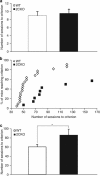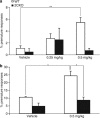Impact of serotonin (5-HT)2C receptors on executive control processes
- PMID: 23303047
- PMCID: PMC3629384
- DOI: 10.1038/npp.2012.258
Impact of serotonin (5-HT)2C receptors on executive control processes
Abstract
Although the serotonin (5-hydroxytryptamine, 5-HT) neurotransmitter system has been implicated in modulating executive control processes such as attention, response inhibition, and behavioral flexibility, the contributions of particular serotonin receptors remain unclear. Here, using operant-based behavioral paradigms, we demonstrate that mice with genetically ablated 5-HT2C receptors (2CKO mice) display deficits in executive functions. 2CKO mice were impaired in the acquisition of a visuospatial attention task as assessed in the 5-choice serial reaction time task (5-CSRTT). In this task, 2CKO mice exhibited marked impairment of attentional processes, with normal response inhibition. We assessed dynamic changes in neurotransmitter levels within the nucleus accumbens (NAc) by in vivo microdialysis in task-performing animals. Extracellular dopamine concentrations were elevated in the NAc of 2CKO mice during task performance, indicating that 5-HT2C receptors impact dopamine homeostasis during a visuospatial attention task. These findings raise the possibility that disinhibition of mesolimbic dopamine pathways contributes to impaired attention and perturbed task performance in 2CKO mice. Additionally, in a spatial reversal learning task, 2CKO mice failed to improve their performance over a series of reversals, indicating that intact 5-HT2C receptor signaling is required to accurately respond to repeated changes in reward contingencies. In contrast to the 2CKO phenotype in the 5-CSRTT, wild-type mice treated with the 5-HT2C receptor antagonist SB242084 exhibited diminished response inhibition, suggesting differing effects of acute pharmacological blockade and constitutive loss of 5-HT2C receptor activity. Altogether, these findings provide insights into the serotonergic regulation of executive control processes and suggest that impaired 5-HT2C receptor signaling during development may predispose to executive function disorders.
Figures





References
-
- Agnoli L, Carli M. Dorsal-striatal 5-HT(2)A and 5-HT(2)C receptors control impulsivity and perseverative responding in the 5-choice serial reaction time task. Psychopharmacology (Berl) 2012;219:633–645. - PubMed
-
- Bari A, Dalley JW, Robbins TW. The application of the 5-choice serial reaction time task for the assessment of visual attentional processes and impulse control in rats. Nat Protoc. 2008;3:759–767. - PubMed

